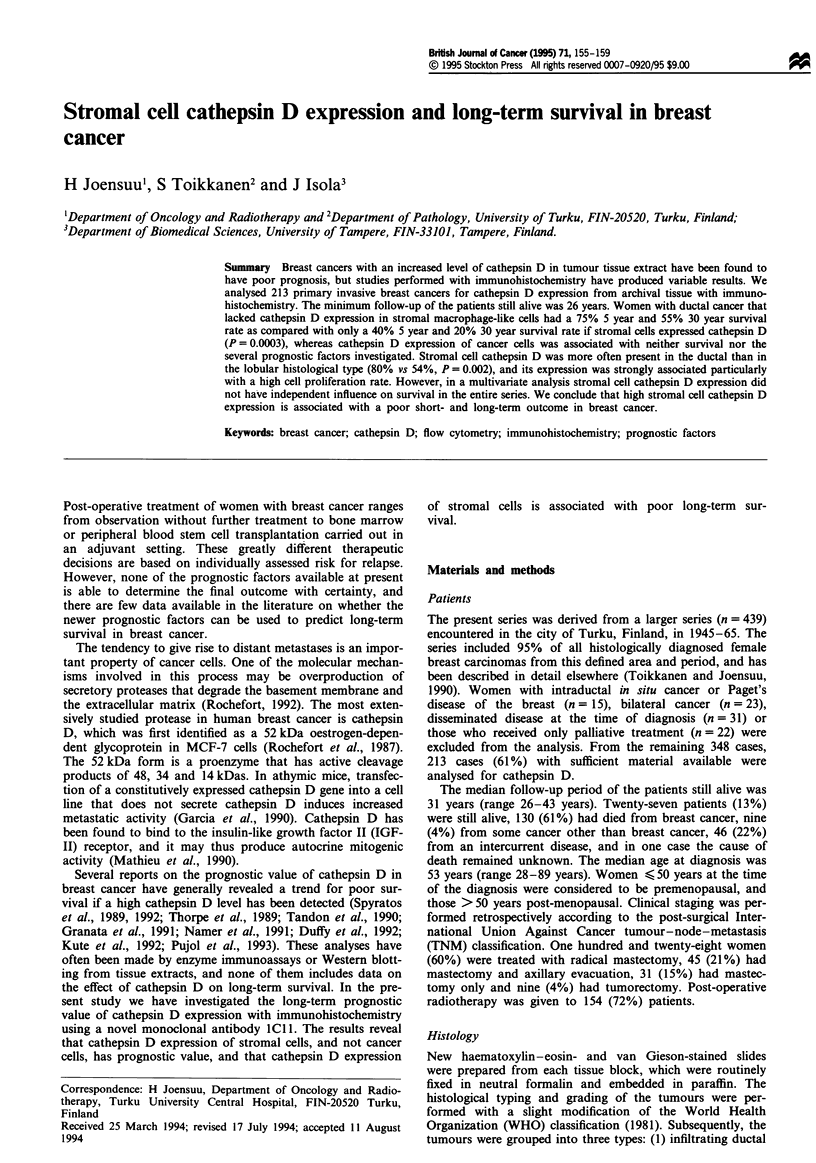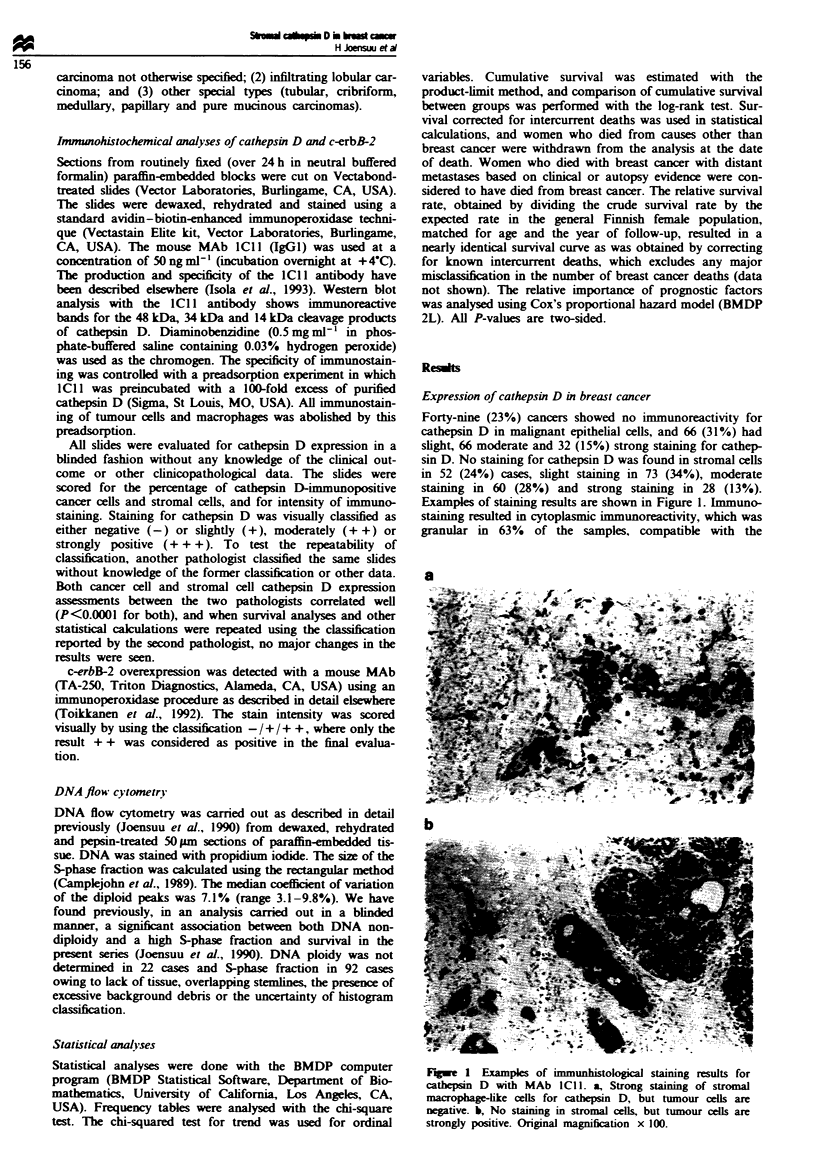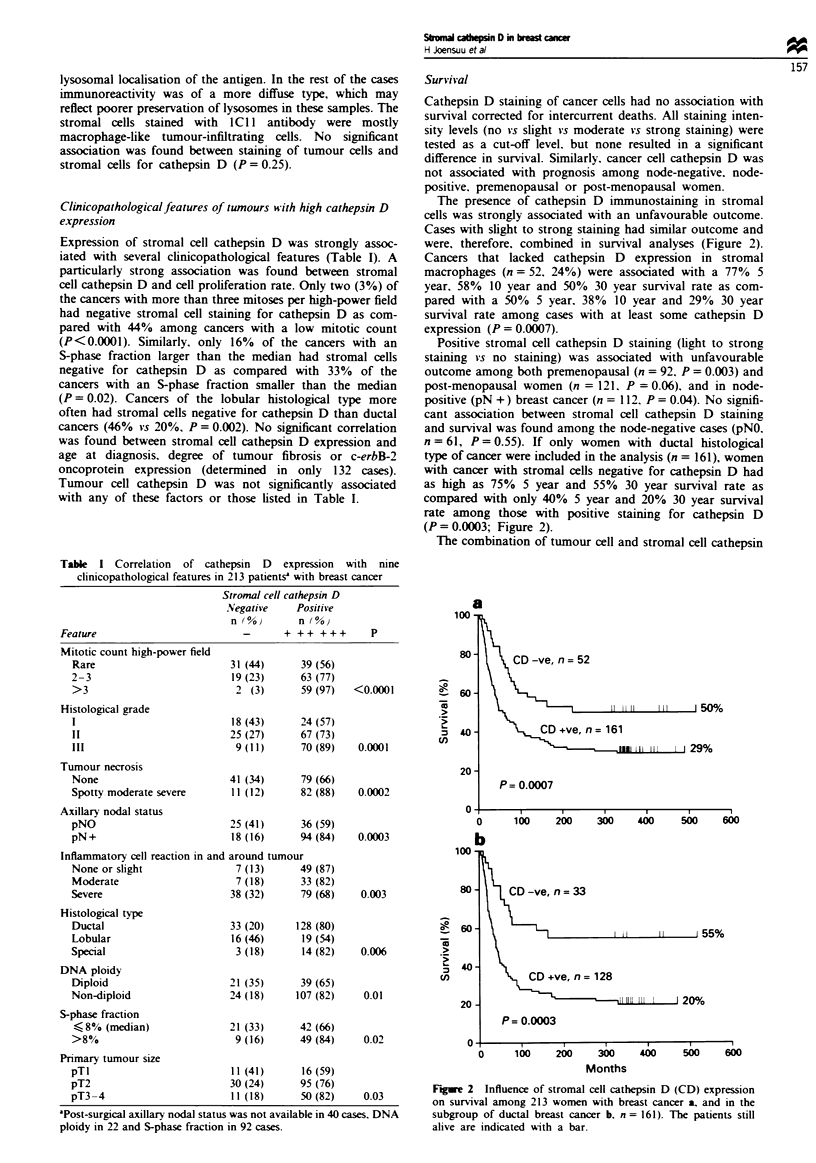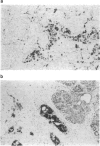Abstract
Breast cancers with an increased level of cathepsin D in tumour tissue extract have been found to have poor prognosis, but studies performed with immunohistochemistry have produced variable results. We analysed 213 primary invasive breast cancers for cathepsin D expression from archival tissue with immunohistochemistry. The minimum follow-up of the patients still alive was 26 years. Women with ductal cancer that lacked cathepsin D expression in stromal macrophage-like cells had a 75% 5 year and 55% 30 year survival rate as compared with only a 40% 5 year and 20% 30 year survival rate if stromal cells expressed cathepsin D (P = 0.0003), whereas cathepsin D expression of cancer cells was associated with neither survival nor the several prognostic factors investigated. Stromal cell cathepsin D was more often present in the ductal than in the lobular histological type (80% vs 54%, P = 0.002), and its expression was strongly associated particularly with a high cell proliferation rate. However, in a multivariate analysis stromal cell cathepsin D expression did not have independent influence on survival in the entire series. We conclude that high stromal cell cathepsin D expression is associated with a poor short- and long-term outcome in breast cancer.
Full text
PDF




Images in this article
Selected References
These references are in PubMed. This may not be the complete list of references from this article.
- Basset P., Bellocq J. P., Wolf C., Stoll I., Hutin P., Limacher J. M., Podhajcer O. L., Chenard M. P., Rio M. C., Chambon P. A novel metalloproteinase gene specifically expressed in stromal cells of breast carcinomas. Nature. 1990 Dec 20;348(6303):699–704. doi: 10.1038/348699a0. [DOI] [PubMed] [Google Scholar]
- Camplejohn R. S., Macartney J. C., Morris R. W. Measurement of S-phase fractions in lymphoid tissue comparing fresh versus paraffin-embedded tissue and 4',6'-diamidino-2 phenylindole dihydrochloride versus propidium iodide staining. Cytometry. 1989 Jul;10(4):410–416. doi: 10.1002/cyto.990100408. [DOI] [PubMed] [Google Scholar]
- Domagala W., Striker G., Szadowska A., Dukowicz A., Weber K., Osborn M. Cathepsin D in invasive ductal NOS breast carcinoma as defined by immunohistochemistry. No correlation with survival at 5 years. Am J Pathol. 1992 Nov;141(5):1003–1012. [PMC free article] [PubMed] [Google Scholar]
- Duffy M. J., Reilly D., Brouillet J. P., McDermott E. W., Faul C., O'Higgins N., Fennelly J. J., Maudelonde T., Rochefort H. Cathepsin D concentration in breast cancer cytosols: correlation with disease-free interval and overall survival. Clin Chem. 1992 Oct;38(10):2114–2116. [PubMed] [Google Scholar]
- Garcia M., Derocq D., Pujol P., Rochefort H. Overexpression of transfected cathepsin D in transformed cells increases their malignant phenotype and metastatic potency. Oncogene. 1990 Dec;5(12):1809–1814. [PubMed] [Google Scholar]
- Granata G., Coradini D., Cappelletti V., Di Fronzo G. Prognostic relevance of cathepsin D versus oestrogen receptors in node negative breast cancers. Eur J Cancer. 1991;27(8):970–972. doi: 10.1016/0277-5379(91)90260-k. [DOI] [PubMed] [Google Scholar]
- Grøndahl-Hansen J., Ralfkiaer E., Kirkeby L. T., Kristensen P., Lund L. R., Danø K. Localization of urokinase-type plasminogen activator in stromal cells in adenocarcinomas of the colon in humans. Am J Pathol. 1991 Jan;138(1):111–117. [PMC free article] [PubMed] [Google Scholar]
- Henry J. A., McCarthy A. L., Angus B., Westley B. R., May F. E., Nicholson S., Cairns J., Harris A. L., Horne C. H. Prognostic significance of the estrogen-regulated protein, cathepsin D, in breast cancer. An immunohistochemical study. Cancer. 1990 Jan 15;65(2):265–271. doi: 10.1002/1097-0142(19900115)65:2<265::aid-cncr2820650214>3.0.co;2-1. [DOI] [PubMed] [Google Scholar]
- Hewitt R. E., Leach I. H., Powe D. G., Clark I. M., Cawston T. E., Turner D. R. Distribution of collagenase and tissue inhibitor of metalloproteinases (TIMP) in colorectal tumours. Int J Cancer. 1991 Nov 11;49(5):666–672. doi: 10.1002/ijc.2910490507. [DOI] [PubMed] [Google Scholar]
- Isola J., Weitz S., Visakorpi T., Holli K., Shea R., Khabbaz N., Kallioniemi O. P. Cathepsin D expression detected by immunohistochemistry has independent prognostic value in axillary node-negative breast cancer. J Clin Oncol. 1993 Jan;11(1):36–43. doi: 10.1200/JCO.1993.11.1.36. [DOI] [PubMed] [Google Scholar]
- Joensuu H., Toikkanen S., Klemi P. J. DNA index and S-phase fraction and their combination as prognostic factors in operable ductal breast carcinoma. Cancer. 1990 Jul 15;66(2):331–340. doi: 10.1002/1097-0142(19900715)66:2<331::aid-cncr2820660222>3.0.co;2-6. [DOI] [PubMed] [Google Scholar]
- Kute T. E., Shao Z. M., Sugg N. K., Long R. T., Russell G. B., Case L. D. Cathepsin D as a prognostic indicator for node-negative breast cancer patients using both immunoassays and enzymatic assays. Cancer Res. 1992 Oct 1;52(19):5198–5203. [PubMed] [Google Scholar]
- Mathieu M., Rochefort H., Barenton B., Prebois C., Vignon F. Interactions of cathepsin-D and insulin-like growth factor-II (IGF-II) on the IGF-II/mannose-6-phosphate receptor in human breast cancer cells and possible consequences on mitogenic activity of IGF-II. Mol Endocrinol. 1990 Sep;4(9):1327–1335. doi: 10.1210/mend-4-9-1327. [DOI] [PubMed] [Google Scholar]
- Maudelonde T., Brouillet J. P., Roger P., Giraudier V., Pages A., Rochefort H. Immunostaining of cathepsin D in breast cancer: quantification by computerised image analysis and correlation with cytosolic assay. Eur J Cancer. 1992;28A(10):1686–1691. doi: 10.1016/0959-8049(92)90069-e. [DOI] [PubMed] [Google Scholar]
- Namer M., Ramaioli A., Fontana X., Etienne M. C., Héry M., Jourlait A., Milano G., Frenay M., François E., Lapalus F. Prognostic value of total cathepsin D in breast tumors. A possible role in selection of chemoresistant patients. Breast Cancer Res Treat. 1991 Oct;19(2):85–93. doi: 10.1007/BF01980938. [DOI] [PubMed] [Google Scholar]
- Paradiso A., Mangia A., Correale M., Abbate I., Ferri G., Piffanelli A., Catozzi L., Amadori D., Riccobon A., De Lena M. Cytosol cathepsin-D content and proliferative activity of human breast cancer. The Comitato Italiano per il Controllo di Qualita del Laboratorio in Oncologia. Breast Cancer Res Treat. 1992;23(1-2):63–70. doi: 10.1007/BF01831477. [DOI] [PubMed] [Google Scholar]
- Poulsom R., Pignatelli M., Stetler-Stevenson W. G., Liotta L. A., Wright P. A., Jeffery R. E., Longcroft J. M., Rogers L., Stamp G. W. Stromal expression of 72 kda type IV collagenase (MMP-2) and TIMP-2 mRNAs in colorectal neoplasia. Am J Pathol. 1992 Aug;141(2):389–396. [PMC free article] [PubMed] [Google Scholar]
- Pujol P., Maudelonde T., Daures J. P., Rouanet P., Brouillet J. P., Pujol H., Rochefort H. A prospective study of the prognostic value of cathepsin D levels in breast cancer cytosol. Cancer. 1993 Mar 15;71(6):2006–2012. doi: 10.1002/1097-0142(19930315)71:6<2006::aid-cncr2820710614>3.0.co;2-q. [DOI] [PubMed] [Google Scholar]
- Pyke C., Kristensen P., Ralfkiaer E., Grøndahl-Hansen J., Eriksen J., Blasi F., Danø K. Urokinase-type plasminogen activator is expressed in stromal cells and its receptor in cancer cells at invasive foci in human colon adenocarcinomas. Am J Pathol. 1991 May;138(5):1059–1067. [PMC free article] [PubMed] [Google Scholar]
- Rochefort H. Biological and clinical significance of cathepsin D in breast cancer. Acta Oncol. 1992;31(2):125–130. doi: 10.3109/02841869209088891. [DOI] [PubMed] [Google Scholar]
- Rochefort H., Capony F., Garcia M., Cavaillès V., Freiss G., Chambon M., Morisset M., Vignon F. Estrogen-induced lysosomal proteases secreted by breast cancer cells: a role in carcinogenesis? J Cell Biochem. 1987 Sep;35(1):17–29. doi: 10.1002/jcb.240350103. [DOI] [PubMed] [Google Scholar]
- Spyratos F., Martin P. M., Hacène K., Romain S., Andrieu C., Ferrero-Poüs M., Deytieux S., Le Doussal V., Tubiana-Hulin M., Brunet M. Multiparametric prognostic evaluation of biological factors in primary breast cancer. J Natl Cancer Inst. 1992 Aug 19;84(16):1266–1272. doi: 10.1093/jnci/84.16.1266. [DOI] [PubMed] [Google Scholar]
- Spyratos F., Maudelonde T., Brouillet J. P., Brunet M., Defrenne A., Andrieu C., Hacene K., Desplaces A., Rouëssé J., Rochefort H. Cathepsin D: an independent prognostic factor for metastasis of breast cancer. Lancet. 1989 Nov 11;2(8672):1115–1118. doi: 10.1016/s0140-6736(89)91487-6. [DOI] [PubMed] [Google Scholar]
- Tandon A. K., Clark G. M., Chamness G. C., Chirgwin J. M., McGuire W. L. Cathepsin D and prognosis in breast cancer. N Engl J Med. 1990 Feb 1;322(5):297–302. doi: 10.1056/NEJM199002013220504. [DOI] [PubMed] [Google Scholar]
- Thorpe S. M., Rochefort H., Garcia M., Freiss G., Christensen I. J., Khalaf S., Paolucci F., Pau B., Rasmussen B. B., Rose C. Association between high concentrations of Mr 52,000 cathepsin D and poor prognosis in primary human breast cancer. Cancer Res. 1989 Nov 1;49(21):6008–6014. [PubMed] [Google Scholar]
- Toikkanen S., Helin H., Isola J., Joensuu H. Prognostic significance of HER-2 oncoprotein expression in breast cancer: a 30-year follow-up. J Clin Oncol. 1992 Jul;10(7):1044–1048. doi: 10.1200/JCO.1992.10.7.1044. [DOI] [PubMed] [Google Scholar]
- Toikkanen S., Joensuu H. Prognostic factors and long-term survival in breast cancer in a defined urban population. APMIS. 1990 Nov;98(11):1005–1014. doi: 10.1111/j.1699-0463.1990.tb05027.x. [DOI] [PubMed] [Google Scholar]
- Vignon F., Capony F., Chambon M., Freiss G., Garcia M., Rochefort H. Autocrine growth stimulation of the MCF 7 breast cancer cells by the estrogen-regulated 52 K protein. Endocrinology. 1986 Apr;118(4):1537–1545. doi: 10.1210/endo-118-4-1537. [DOI] [PubMed] [Google Scholar]



